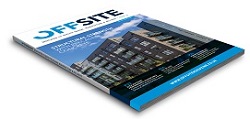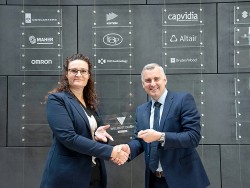Mark Farmer said, 'Modernise or Die' and whilst this message has generally been accepted by the construction and infrastructure industry, it may not be clear what 'modernisation' actually means. Mark Ireland, Chief Engineer, Construction at the Manufacturing Technology Centre (MTC) explains more.
One parallel which can be drawn is to the automotive industry. In the 1950s 40 manufacturers in the UK produced approximately 785,000 vehicles per year. By the 1970s four main companies dominated the market and vehicle manufacturing achieved - an unbeaten record of - 2,098,000 vehicles in 1972. A remarkable increase in a relatively short period of time. One of the drivers for this increase was a move away from skilled labour delivering bespoke manufactured products, made in sheds, to huge production facilities with investment in design, inspection, logistics and manufacturing technologies. The smaller companies who couldn't make the investment, to compete, became low volume niche vehicle manufacturers, went bust or were absorbed into the larger corporations.
In my view, the UK construction and infrastructure industry is in the same position as the automotive industry in the 1950s and will inevitably go through the same change, provided global exports don't destroy the industry first (as happened to the automotive industry in the 1980s and 1990s). So, is a manufacturing approach the secret to "modernisation"?
Design
One of the tools that we know is proven in other sectors is good, complete, engineering design before a project is committed. This needs to include design for manufacture, assembly, maintenance, disassembly etc., often called Design for X or DFX. There are a number of quantitative and qualitative tools that can be used but fundamentally an assembly needs to be fully defined such that the quality of a product or building should not be dependent on the person making it. There are also a few tricks that can be applied from other sectors such as; modularising products and sub-assemble as much as you can and test it before you build it into the finished product. Components such as Bryden Wood's ceiling cassette (see Image 1) show that this is achievable today but also that there is still a long way to go to change the way construction thinks about components. Do you really want all of the wiring in your house bespoke made or a pre-made and tested wiring loom complete with tested and validated connectors? The future needs collaboration with suppliers and product integrators to provide sub-assemblies which are designed with DFX in mind and not just what is on the shelf.
Logistics
In a manufacturing approach it is known that Just-In-Time, carefully packaged, fully sequenced part delivery minimises business overheads whilst increasing product quality with less risk of parts getting damaged during storage. In the automotive industry, £3.50 glossy plastic trim pieces are handled with gloves and stored in special packaging whilst in construction we have to do our best not to damage products which are delivered to site at the wrong time. Currently around 20% of plasterboard is damaged during transport, there is a tendency for skilled trades to work around this problem, masking the scale of the issue but what is the impact of cost, defects and poor quality on projects later down the line? In a future world of construction parts will be delivered at the right quality at the right time for just in time assembly with custom made re-usable packaging.
Inspection
Inspection doesn't just mean measure what you have done it also includes measurement of the inputs and the process. In construction and infrastructure the general challenge is measuring 'as built' but by this point it is too late to do anything about it without accruing re-work costs. It is generally accepted in manufacturing that if you measure the input and the processing you know that the output is going to be of good quality. When parts are being made as sub-assemblies, functional testing can be completed before assembly into a building or system, supporting the improvement in quality and right first time.
Manufacturing Technology
One major difference to the more established manufacturing industries is the type of technology which is going to be needed in the future construction supply chain. While the industry moves to off-site and ultimately define the direction in terms of materials and processes, investment in flexible equipment with minimum hard tooling is going to be vital. Hard tooling e.g. press tooling, offers low cost at high rate but until standardisation can be achieved this is going to be limited to commodity products.
One of the biggest areas of opportunity for construction is to use laser and water jet cutting. These proven process can be deployed on a large scale and are exceptionally accurate, allowing pieces to be 'jig sawed' together with sub mm accuracy. Standardised, self-locating and high tolerance connections will allow for components to be accurately assembled without the need for shimming and fitting. In conjunction with laser cutting, CNC folding and bending methodologies can be used to give metal components the form they need to become part of assemblies with minimum investment in dedicated tooling.
Robotics and Automation
Robotics and automation has two main areas of opportunity:
Flexible conventional automation for offsite processing and assembly work. All of the equipment and understanding is proven and available off the shelf today but to make it work the DFx approach is needed to design structures and systems which support automation, trying to automate a manual task rarely works but when integrated early into design work huge benefits can be realised. When integrated into re-configurable tooling and fixturing systems automation can be rapidly built up, used on a project then reconfigured for the next project allowing the
Flexible mobile automation/semi-automated positioning and fixing. In a future world of construction there should be an aspiration to remove general use of cranes and slinging to sites with semi-automated handling and fitting of components. The industry is starting to move towards self-driving equipment but the key to automation is starting become more mainstream through companies such as Trimble and, if integrated with equipment such as the JCB Hydradig large robotic equipment, is almost a reality today.
The Customer
The final piece of the jigsaw puzzle is meeting the requirements of an ever more demanding customer. Currently construction and infrastructure projects don't deliver what we need as users. Using housing as an example, why do we not have electric windows, central locking, integrated security systems, climate control, single point service integration for water, gas, electricity etc. Why do nearly all garages get used to store items other than cars? We should be able to play music as loud as we want without disturbing anyone but I don't want to hear anyone else in the bathroom. Designers have yet to come up with an innovative product design that reflects how we really use our house. We have started to demand more from our mobile phones, white goods, cars, and product development is a key part of differentiation for suppliers but in housing, choice is driven by cost and location.
A manufacturing approach should be used to develop offsite, modularisation and sub-assembly for construction, but as we all know these approaches have been tried before and don't necessarily come with a good reputation. The failures in the past were driven by a desire to achieve cheaper and faster but not better. By using better design, logistics, inspection and manufacturing technologies we can have Better, Faster and Cheaper!
For more information visit: www.the-mtc.orgTo read the full article in Offsite Magazine, go to the digital version of Issue 13 









